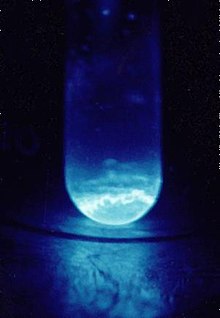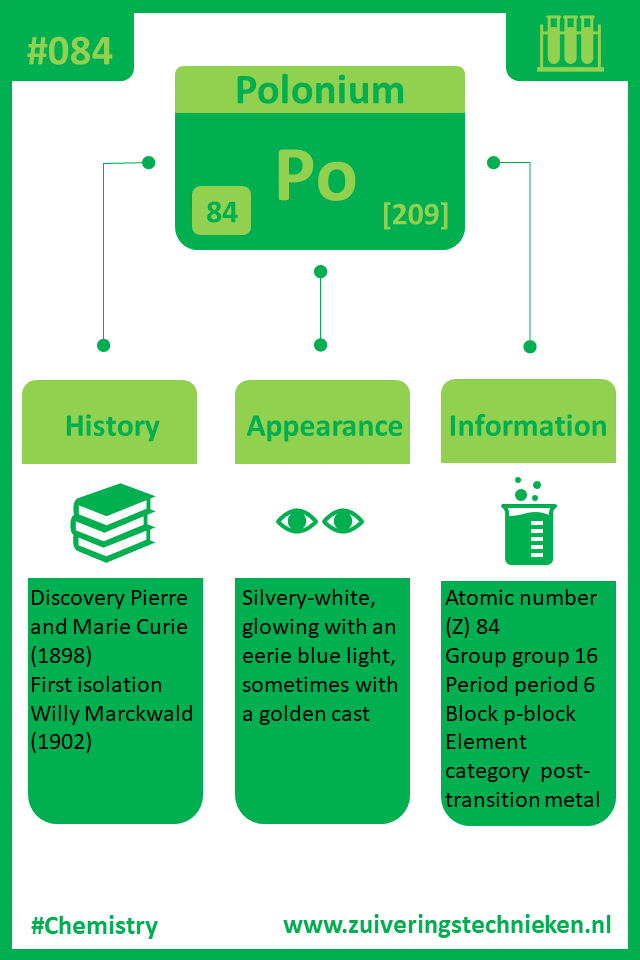An Atom Of The Element Of Atomic Number 84 And Mass Number 199emits An α Particle.
Polonium is a highly radioactive element. It was discovered in 1989 owing to its highly radioactive nature.
Polonium (atomic number 84, symbol Po) is a radioactive element and a very rare semi-metal. The element has 33 radioactive isotopes, including polonium-208 and polonium-210. It is a scarce element that is produced in nuclear reactors. Neurons are used to bombard bismuth-209, and bismuth-210 is formed as a result. It is made in very small qunatities through a nuclear reaction of bismuth. Neutron irradiation of 209 bismuth (atomic number 83) gives 210 polonium (atomic number 84). 209 Bi + 1 n → 210 Po + e-Metallic polonium can be fractionally distilled from the bismuth or electrodeposited onto a metal surface such as silver.
History and Discovery
Polonium was discovered by Marie and Pierre Curie from the ores of uranium in 1989. It was identified as a distinct element due to its highly radioactive nature. Later, in 1902, Willy Marckwald was able to isolate around 3 milligrams of polonium. Commercial production of polonium started during the 2nd World War in US. It was used as the crucial component of the nuclear weapon, Fat Man bomb that was detonated on Nagasaki in 1945 [1]. The name of the element has been derived from the word Polonia, that is Latin for Poland. So, it is basically named after the homeland of its discoverer, the Curies [2].
Polonium
What Element Has Atomic Number 84
| Periodic Table Classification | Group 16 Period 6 |
|---|---|
| State at 20C | Solid |
| Color | Silvery |
| Electron Configuration | [Xe] 4f14 5d10 6s2 6p4 |
| Electron Number | 84 |
| Proton Number | 84 |
| Electron Shell | 2, 8, 18, 32, 18, 6 |
| Density | 9.30 g.cm-3 at 20°C |
| Atomic number | 84 |
| Atomic Mass | 209.00 g.mol -1 |
| Electronegativity according to Pauling | 2.00 |

Occurrence
Polonium is a very rare element. It is highly radioactive and has a short half-life, so its natural abundance is very limited and is present in trace amounts. It occurs in uranium ores and is considered as the daughter of uranium-238, as it is formed during the process of radioactive decay of parent element, uranium. In uranium ores, it is present in about 0.1 mg per metric ton. The natural amount of polonium in the Earth crust is not harmful. Polonium is also formed artificially by the neutron irradiation of bismuth, but this process also yields only milligrams of polonium. Polonium has also been reported to be present in smoke of tobacco leaves that are grown in fertilizers containing phosphate. Traces of polonium have been found to be present in sea food.
Physical Characteristics
Polonium is a shiny silver metal. It exists in two allotropic forms, alpha and beta. The alpha form exists in a single atom arranged in a cubic crystal at standard temperature and pressure. While the beta form exists in a complex rhombohedral structure [3]. The atomic number of polonium is 84 and atomic mass is 209.

Chemical Characteristics
Polonium compounds have a wide range of oxidation states: 4, 2, -2. There are very few naturally occurring compounds of polonium. There are around 50 synthetic or artificially made compounds of polonium. Due to its highly reactive nature, it causes radiolysis of chemical bonds and little is known about the chemical characteristics and compounds of polonium.
Significance and Uses
- Polonium is used as a source of alpha particles by various industries for measuring thickness of coatings.
- Polonium produce intense alpha particles that generate considerable heat, which is used as source of atomic heat to run radioisotope thermoelectric generators in moon rovers and various satellites.
- Polonium-beryllium alloys are used as trigger or neutron in initiators of nuclear weapons.
- Polonium is used for discovering oil wells.
- Polonium is used a source of static charge in making photographic plates, plastic sheets etc.
Health Hazards
Atomic Number 84
Polonium is a highly toxic element. Its acute radioactivity makes it very dangerous and is considered more toxic than hydrogen cyanide (polonium-210 is about 250,000 times more toxic). The alpha particles produced by polonium can cause severe damage to organic tissues when absorbed, ingested or inhaled. On average, exposure of acute polonium radiation of around 4.5 Sv is considered as the lethal dose (LD50). The biological half-life of polonium-210 is around 50 days and the lethal does of polonium-210 is 0.089 microgram. Theoretically, one 1 gram of polonium-210 can adverse effect 20 million people and half of them will die [4].
Atomic Number 84 Crossword Clue
Isotopes of Polonium
Polonium have 33 known isotopes. Polonium is highly radioactive, and all its isotopes are highly unstable and radioacitve. The atomic masses of polonium isotopes range in atomic masses from 188 to 220u. Poloium-214, polonium-210 and polonium-218 are produced during the decay chain of uranium-238. Polonium-209 is the most stable isotope and have a half-life of around 125 years [5].

REFERENCES
[1]. Nuclear Weapons FAQ, Section 4.1, Version 2.04: 20 February 1999. Nuclearweaponarchive.org. Retrieved on 2013-04-28.
[2]. Pfützner, M. (1999). “Borders of the Nuclear World – 100 Years After Discovery of Polonium”. Acta Physica Polonica B. 30: 1197. Bibcode:1999AcPPB..30.1197P
[3]. The beta Po (A_i) Structure”. Naval Research Laboratory. 2000-11-20. Archived from the original on 2001-02-04. Retrieved 2009-05-05
[4]. Carey Sublette (2006-12-14). “Polonium Poisoning”. Retrieved 2009-05-05
[5]. Boutin, Chad. “Polonium’s Most Stable Isotope Gets Revised Half-Life Measurement”. nist.gov. NIST Tech Beat. Retrieved 9 September 2014
Other Periodic Table Elements
- Uranium
Uranium is a weakly radioactive element discovered in 1789 by Martin Heinrich Klaproth. It is…
- Astatine
Astatine is a highly radioactive element and the heaviest member of halogen family. It was…
- Francium
Francium was discovered in 1939. It is very unstable alkali metal and considered the second…
